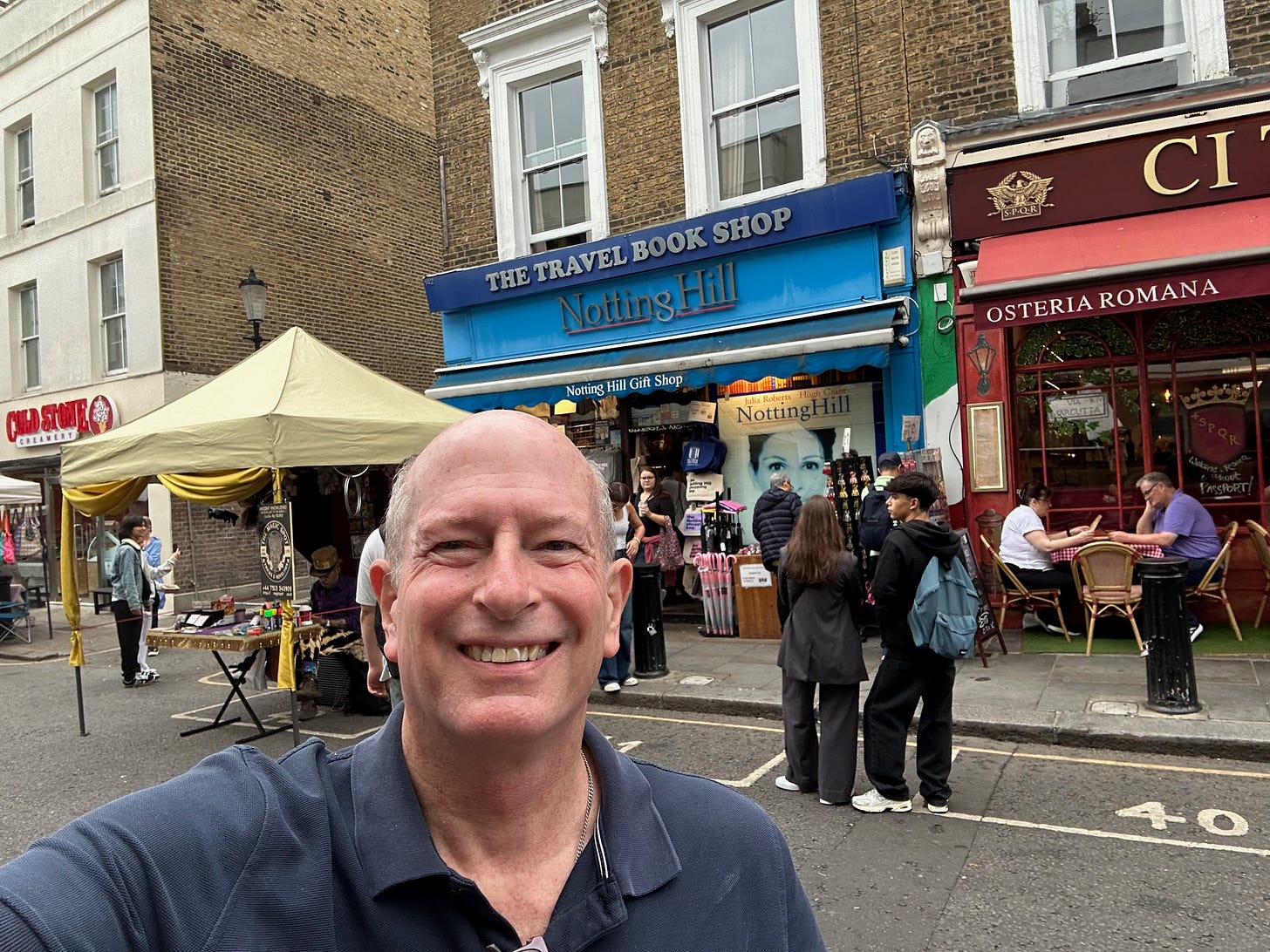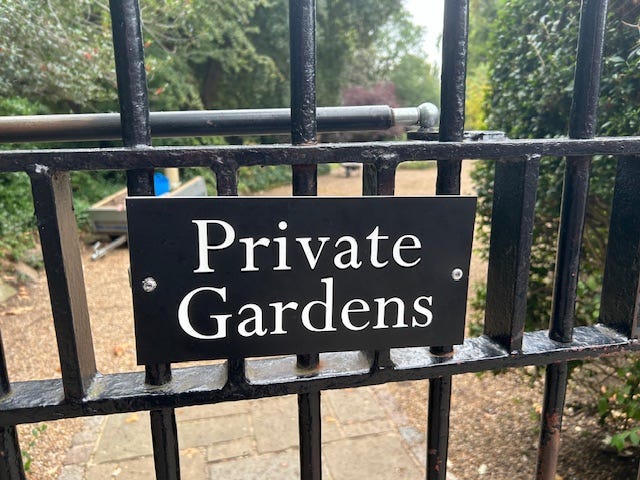Visiting Notting Hill Film Locations in London
Only have a day between flights and have already seen Big Ben? Check out these iconic London sites instead
I’m back in London, dropping off my British grandkids after their annual Beach Boys summer in America with their relatives.
Feisty tweens, they’ve gone completely native, prancing about in shorts and t-shirts and affecting the broadest Valley Girl accents they can muster whenever they wish to mock their American aunties and uncles.
(To be fair, it’s only retaliation for our own pathetic attempts to imitate Jeeves and declare it’s time for their “baaaaahths.”)
My secret for staying alive in London is to obey the traffic laws fanatically.
Back home, I’m more flexible, more than willing to blow through stop signs in areas where I can see no cars in either direction.
But in London, such a policy is suicide. Jaywalking can mean sudden death.
When walking about, every tourist quickly learns that British road rules create situations that can become positively fatal for foreigners unaccustomed to them.
Because the English insist on driving on the wrong side of the road, and because London is a maze of streets converging in odd configurations not familiar to those used to the simple tic-tac-toe regularity of American street layouts, this means that cars can appear out of nowhere with terrifying and largely supernatural speed.
More than once, I’ve been about to step into a quiet road in some London neighborhood I assume is empty when out of the mist appears a red double-decker bus careening around a corner from an angle that no American could possibly expect — such as from your right.
This is now even more likely because many of those double-decker red buses are now proudly all-electric and eerily silent.
As a result, I’ve developed a fanatical loyalty to British traffic laws.
When a red light announces, “Don’t Cross,” I stand like a soldier at attention — while locals, of course, skip across the street cheerfully ignoring the warnings with the same scofflaw attitude I have at home.
I don’t care. In London, I obey the law to the letter.
When the little painted street signs say, “Look Right!”, I look right, just as a lumbering lorry almost smashes me into a bloody mass of tourist flesh.
Down in the Tube, I definitely Mind the Gap. It’s saved my life countless times.
The question I now face is, what do you do in London when you’ve seen all of the usual tourist sites and only have a day between flights?
I’m off to Budapest for a week and can’t stand just hanging around my Paddington hotel — not when a city as exciting and fun as London is right outside my door.
I decide to visit all the sites from the movie Notting Hill, one of my Anglophile family’s favorites. I always stay in Paddington, right off Hyde Park, and the Notting Hill Gate Tube station is just one stop away on the Central Line.
I head first to the most promising site, William Thacker’s iconic Travel Bookstop at 142 Portobello Road.
While never actually a bookshop, travel or otherwise, it still looks remarkably like the one in the film, thanks to the owners maintaining the same color scheme and hanging a little awning over the front facade with the words, “The Travel Book Stop” on it.
I walk into the shop, a typical tourist boutique full of London and Notting Hill knickknacks, and imagine it lined with travel books. Pretty close!
Outside, Portobello Road looks very much like the scenes from the film, with little stands selling everything from fresh fruit to arty, handmade jewelry.
I can almost see Hugh Grant walking though the seasons from stand to stand, his mop of brown hair waving in the wind. It’s a charming stroll.
The street is filled with locals and tourists looking in the windows of the many fun shops that line the way.
However, I have no time to waste. There are many sites from the film to see. Most of the film was indeed shot in Notting Hill.
However, Hollywood can be disappointing.
I walk over to see William Thatcher/Hugh Grant’s flat in the movie, located just a few blocks away at 280 Westbourne Park Road.
At the time of filming, it was owned by the film’s screenwriter, Richard Curtis, who sold it right after Notting Hill came out for the then-impressive price of £1.3 million.
As more than one observer has pointed out, this makes the film the most expensive real estate ad in history.
Much more impressive is the home of the characters Bella and Max (Gina McKee and Tim McInnerny), where William brings the movie star Anna (Julia Roberts) to meet his ordinary London friends.
It’s located at 92 Landsdowne Road, a very impressive row of upscale London townhouses, near the private Rosmead Gardens they break into.
I decide those gardens will be the last stop on my private Notting Hill tour. It’s starting to drizzle a little and I’ve already more than exceeded my daily 10,000 steps.
The gardens are more impressive in person than in the movie. Large trees loom over the surrounding buildings.
Even though you can’t get into them, a careful observer can see the gardens are pretty big, extending for what seems to be entire city blocks with rows of multi-million-pound townhouses sharing and protecting them.
Rosmead Road is a small roadway of about half a block, with a large, dilapidated black iron gate the only entrance to the private gardens on this street.
The imposing iron fence that William climbs to impress Anna that he, at least, isn’t intimidated by petty laws and regulations — the same laws and regulations I obey religiously in London — is daunting but also collapsing from the weight of greenery that covers most of it.
I assume this isn’t even a real entrance and that the locals use other, secret entrances not marked on maps, such as doorways from their own townhouses and apartment buildings.
Nevertheless, I nosily try to put my Iphone between the iron bars to snap a few photos but the foliage is so thick you can’t see much.
Later, walking back toward Notting Hill Gate along Kensington Park Road, I see even more impressive private gardens plainly visible from the street with well-tended lawns, crushed gravel walkways and even a tennis court inside.
A sign on their gate plainly states, “Private Gardens.”
I can see why American expats, in particular, enjoy living in this area of London, assuming they can afford it.
The streets are quiet, the homes understated but beautiful, you’re just steps from every shop you could want and the Tube station is right there.
All in wall, a satisfying afternoon and a series of tourist sites that, while not on the Top 20 Things to Do in London, are definitely worth seeing if you have the time.
I enjoy both literary and film tourism if the payoff is there — and I can honestly say that, for anyone who enjoys the film Notting Hill, the payoff is there.
Now I’m off to a very different place… my first visit to Budapest.
More later.
Robert J. Hutchinson is a veteran writer and author of numerous books of popular history. Email him at roberthutchinson@substack.com.






